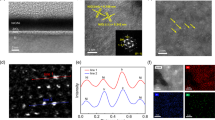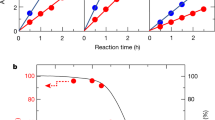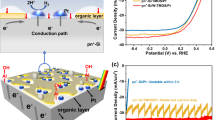Abstract
Photoelectrochemical (PEC) water splitting to produce hydrogen fuel was first reported 50 years ago1, yet artificial photosynthesis has not become a widespread technology. Although planar Si solar cells have become a ubiquitous electrical energy source economically competitive with fossil fuels, analogous PEC devices have not been realized, and standard Si p-type/n-type (p–n) junctions cannot be used for water splitting because the bandgap precludes the generation of the needed photovoltage. An alternative paradigm, the particle suspension reactor (PSR), forgoes the rigid design in favour of individual PEC particles suspended in solution, a potentially low-cost option compared with planar systems2,3. Here we report Si-based PSRs by synthesizing high-photovoltage multijunction Si nanowires (SiNWs) that are co-functionalized to catalytically split water. By encoding a p-type–intrinsic–n-type (p–i–n) superlattice within single SiNWs, tunable photovoltages exceeding 10 V were observed under 1 sun illumination. Spatioselective photoelectrodeposition of oxygen and hydrogen evolution co-catalysts enabled water splitting at infrared wavelengths up to approximately 1,050 nm, with the efficiency and spectral dependence of hydrogen generation dictated by the photonic characteristics of the sub-wavelength-diameter SiNWs. Although initial energy conversion efficiencies are low, multijunction SiNWs bring the photonic advantages of a tunable, mesoscale geometry and the material advantages of Si—including the small bandgap and economies of scale—to the PSR design, providing a new approach for water-splitting reactors.
This is a preview of subscription content, access via your institution
Access options
Access Nature and 54 other Nature Portfolio journals
Get Nature+, our best-value online-access subscription
$29.99 / 30 days
cancel any time
Subscribe to this journal
Receive 51 print issues and online access
$199.00 per year
only $3.90 per issue
Buy this article
- Purchase on Springer Link
- Instant access to full article PDF
Prices may be subject to local taxes which are calculated during checkout




Similar content being viewed by others
Data availability
Device metrics are contained in Extended Data Tables 1–3. Source data are provided with this paper.
References
Fujishima, A. & Honda, K. Electrochemical photolysis of water at a semiconductor electrode. Nature 238, 37–38 (1972).
Pinaud, B. A. et al. Technical and economic feasibility of centralized facilities for solar hydrogen production via photocatalysis and photoelectrochemistry. Energ. Environ. Sci. 6, 1983–2002 (2013).
Fabian, D. M. et al. Particle suspension reactors and materials for solar-driven water splitting. Energ. Environ. Sci. 8, 2825–2850 (2015).
Wang, Q. & Domen, K. Particulate photocatalysts for light-driven water splitting: mechanisms, challenges, and design strategies. Chem. Rev. 120, 919–985 (2020).
Duonghong, D., Borgarello, E. & Graetzel, M. Dynamics of light-induced water cleavage in colloidal systems. J. Am. Chem. Soc. 103, 4685–4690 (1981).
Kim, J. et al. Highly efficient overall water splitting through optimization of preparation and operation conditions of layered perovskite photocatalysts. Top. Catal. 35, 295–303 (2005).
Kato, H., Asakura, K. & Kudo, A. Highly efficient water splitting into H2 and O2 over lanthanum-doped NaTaO3 photocatalysts with high crystallinity and surface nanostructure. J. Am. Chem. Soc. 125, 3082–3089 (2003).
Kim, H. G., Hwang, D. W., Kim, J., Kim, Y. G. & Lee, J. S. Highly donor-doped (110) layered perovskite materials as novel photocatalysts for overall water splitting. Chem. Commun. 12, 1077–1078 (1999).
Takata, T. et al. Photocatalytic water splitting with a quantum efficiency of almost unity. Nature 581, 411–414 (2020).
Wang, Q. et al. Oxysulfide photocatalyst for visible-light-driven overall water splitting. Nat. Mater. 18, 827–832 (2019).
Luo, L. & Maggard, P. A. Effect of ligand coordination on the structures and visible-light photocatalytic activity of manganese vanadate hybrids. Cryst. Grow. Des. 13, 5282–5288 (2013).
Maeda, K. & Domen, K. Photocatalytic water splitting: recent progress and future challenges. J. Phys. Chem. Lett. 1, 2655–2661 (2010).
Reece, S. Y. et al. Wireless solar water splitting using silicon-based semiconductors and earth-abundant catalysts. Sci. 334, 645–648 (2011).
Kempa, T. J. et al. Single and tandem axial p-i-n nanowire photovoltaic devices. Nano. Lett. 8, 3456–3460 (2008).
Mohite, A. D. et al. Highly efficient charge separation and collection across in situ doped axial VLS-grown Si nanowire p–n junctions. Nano. Lett. 12, 1965–1971 (2012).
Jung, Y., Vacic, A., Perea, D. E., Picraux, S. T. & Reed, M. A. Minority carrier lifetimes and surface effects in VLS-grown axial p–n junction silicon nanowires. Adv. Mater. 23, 4306–4311 (2011).
Gabriel, M. M. et al. Imaging charge separation and carrier recombination in nanowire p-i-n junctions using ultrafast microscopy. Nano. Lett. 14, 3079–3087 (2014).
Hill, D. J., Teitsworth, T. S., Ritchie, E. T., Atkin, J. M. & Cahoon, J. F. Interplay of surface recombination and diode geometry for the performance of axial p–i–n nanowire solar cells. ACS Nano. 12, 10554–10563 (2018).
Cordoba, C., Teitsworth, T. S., Yang, M., Cahoon, J. F. & Kavanagh, K. Abrupt degenerately-doped silicon nanowire tunnel junctions. Nanotechnol. 31, 415708 (2020).
Hill, D. J., Teitsworth, T. S., Kim, S., Christesen, J. D. & Cahoon, J. F. Encoding highly nonequilibrium boron concentrations and abrupt morphology in p-type/n-type silicon nanowire superlattices. ACS Appl. Mater. Interfaces 9, 37105–37111 (2017).
Ritchie, E. T. et al. Mapping free-carriers in multijunction silicon nanowires using infrared near-field optical microscopy. Nano Lett. 17, 6591–6597 (2017).
Su, Y. et al. Single-nanowire photoelectrochemistry. Nat. Nanotechnol. 11, 609–612 (2016).
Kim, S. & Cahoon, J. F. Geometric nanophotonics: light management in single nanowires through morphology. Acc. Chem. Res. 52, 3511–3520 (2019).
Holmberg, V. C., Bogart, T. D., Chockla, A. M., Hessel, C. M. & Korgel, B. A. Optical properties of silicon and germanium nanowire fabric. J. Phys. Chem. C 116, 22486–22491 (2012).
Gerken, J. B. et al. Electrochemical water oxidation with cobalt-based electrocatalysts from pH 0–14: the thermodynamic basis for catalyst structure, stability, and activity. J. Am. Chem. Soc. 133, 14431–14442 (2011).
Christesen, J. D. et al. Design principles for photovoltaic devices based on Si nanowires with axial or radial p–n junctions. Nano Lett. 12, 6024–6029 (2012).
Mujica, M. et al. The geode process: hollow silica microcapsules as a high surface area substrate for semiconductor nanowire growth. ACS Appl. Nano Mater. 3, 905–913 (2020).
Royea, W. J., Juang, A. & Lewis, N. S. Preparation of air-stable, low recombination velocity Si(111) surfaces through alkyl termination. Appl. Phys. Lett. 77, 1988–1990 (2000).
Bansal, A. & Lewis, N. S. Stabilization of Si photoanodes in aqueous electrolytes through surface alkylation. J. Phys. Chem. B 102, 4058–4060 (1998).
Bywalez, R., Karacuban, H., Nienhaus, H., Schulz, C. & Wiggers, H. Stabilization of mid-sized silicon nanoparticles by functionalization with acrylic acid. Nanoscale Res. Lett. 7, 76 (2012).
Luttmer, J. D. & Trachtenberg, I. Performance predictions for solar‐chemical converters based on photoelectrochemical I‐V curves. J. Electrochem. Soc. 132, 1312–1315 (1985).
Mangolini, L., Thimsen, E. & Kortshagen, U. High-yield plasma synthesis of luminescent silicon nanocrystals. Nano Lett. 5, 655–659 (2005).
Heath, J. R. A liquid-solution-phase synthesis of crystalline silicon. Science 258, 1131–1133 (1992).
Vargas-Estevez, C. et al. Suspended silicon microphotodiodes for electrochemical and biological applications. Small 13, 1701920 (2017).
Ohiri, U. et al. Reconfigurable engineered motile semiconductor microparticles. Nat. Commun. 9, 1791 (2018).
Heinrich, J. L., Curtis, C. L., Credo, G. M., Sailor, M. J. & Kavanagh, K. L. Luminescent colloidal silicon suspensions from porous silicon. Sci. 255, 66–68 (1992).
Christesen, J. D., Pinion, C. W., Zhang, X., McBride, J. R. & Cahoon, J. F. Encoding abrupt and uniform dopant profiles in vapor–liquid–solid nanowires by suppressing the reservoir effect of the liquid catalyst. ACS Nano 8, 11790–11798 (2014).
Kim, S. et al. Designing morphology in epitaxial silicon nanowires: the role of gold, surface chemistry, and phosphorus doping. ACS Nano 11, 4453–4462 (2017).
Sze, S. M. & Ng, K. K. Physics of Semiconductor Devices 3rd edn (Wiley-Interscience, 2007).
Taubner, T., Hillenbrand, R. & Keilmann, F. Performance of visible and mid-infrared scattering-type near-field optical microscopes. J. Microsc. 210, 311–314 (2003).
Acknowledgments
This research was supported by the National Science Foundation (NSF) under award no. CBET-1914711, with foundational work supported by the Alliance for Molecular PhotoElectrode Design for Solar Fuels, an Energy Frontier Research Center funded by the US Department of Energy, Office of Science, Office of Basic Energy Sciences under award no. DE-SC0001011. Device fabrication and electron microscopy imaging and analysis were performed in part at the Chapel Hill Analytical and Nanofabrication Laboratory, a member of the North Carolina Research Triangle Nanotechnology Network, which is supported by the NSF (ECCS-2025064) as part of the National Nanotechnology Coordinated Infrastructure. We thank the Research Computing group at University of North Carolina at Chapel Hill for providing computational resources for the optical simulations. E.T.R. and J.M.A. acknowledge support from the NSF under award CHE-1848278 for s-SNOM characterization. HRTEM and STEM-EDS measurements were performed in part at the Vanderbilt Institute of Nanoscale Science and Engineering. D.J.H. and S.R.L. acknowledge individual NSF graduate research fellowships.
Author information
Authors and Affiliations
Contributions
T.S.T., D.J.H., S.R.L., S.R.B., S.E.M. and J.P.C. synthesized wires and made electrical devices. T.S.T., D.J.H., S.K. and J.-S.P. performed SiNW optical simulations. T.S.T. and A.D.T. designed and performed the PSR experiments. E.T.R. and J.M.A. performed s-SNOM measurements. J.R.M. collected the STEM-EDS spectra and elemental maps for the functionalized wires. T.S.T. and J.F.C. wrote the manuscript with input from all authors. J.F.C. secured funding and conceptualized and supervised all aspects of the research.
Corresponding author
Ethics declarations
Competing interests
The authors declare no competing interests.
Peer review
Peer review information
Nature thanks Paul Maggard and the other, anonymous, reviewer(s) for their contribution to the peer review of this work.
Additional information
Publisher’s note Springer Nature remains neutral with regard to jurisdictional claims in published maps and institutional affiliations.
Extended data figures and tables
Extended Data Fig. 1 Effect of hydrogen anneal on PV performance.
a, I-V curves for N = 5 n-i-p SiNW PV devices with an anneal (orange) and with no anneal (cyan) under 1-sun illumination. b, ISC for N = 5 and 10 n-i-p PV devices with an anneal (orange) and without an anneal (cyan).
Extended Data Fig. 2 Single N = 10 n-i-p SiNW PV device under multi-sun illumination.
a, The I-V curves of a N = 10 SiNW under 1.3 sun (red), 2.5-sun (orange), 4.3-sun (cyan), 7.2-sun (purple), 9.4-sun (green), and 11.3-sun (magenta) illumination. b, The dependence of ISC (cyan) and VOC (orange) on the illumination intensity for the SiNW shown in panel a. Solid lines show the linear fit (cyan) and logarithmic fit (orange) for the ISC and VOC trends, respectively. c, Dark I-V curve (cyan) of the same SiNW with a fit to the ideal diode equation modified to include RS (yellow, dashed), yielding a normalized ideality factor (n/N), Io, and RS of 1.53, 234 fA, and 36 GΩ, respectively. d, Plot of ln(ISC) vs. VOC from the multi-sun illumination data shown in panels a-b. Dashed line represents a fit to the ideal diode equation, yielding a normalized ideality factor and Io of of 1.27 and 51 fA respectively.
Extended Data Fig. 3 STEM EDS of photoelectrochemically deposited co-catalysts.
a-b, STEM high-angle annular dark field (HAADF) images (far left) and color-coded EDS maps (right) of individual elements for the MJ SiNWs shown in main text Fig. 3a (panel a) and main text Fig. 3b (panel b); scale bars, 100 nm for panel a and 200 nm for panel b. The apparent oxygen signal from the Pt shell in panel a is an artifact arising from a strong background x-ray signal, as no oxygen peaks are present in the EDS spectra (not shown) integrated over the Pt shell only.
Extended Data Fig. 4 Electron microscopy images of N = 15 SiNWs co-functionalized with Pt and CoOx co-catalysts.
a, SEM images of two co-functionalized n-i-p SiNWs; scale bars, 5 μm. Insets: higher magnification images of the dashed boxed regions showing the n-type bases with Pt (left) and p-type tips with CoOx (right); scale bars, 200 nm. Pt deposition was only evident on the n-type base of a fraction of the SiNWs, and the amount of deposited material was small compared to CoOx deposition on the p-type base of p-i-n SiNWs. b, TEM images of the Pt-functionalized n-type tip of a p-i-n SiNW at low magnification (left) and higher magnification (right), showing the polycrystalline nature of the deposited Pt nanoparticles; scale bars, 100 nm (left) and 10 nm (right). c, TEM images of the CoOx functionalized p-type base of the same p-i-n SiNW shown in panel b at low magnification (left) and higher magnification (right), showing the amorphous nature of the deposited CoOx; scale bars, 200 nm (left) and 10 nm (right).
Extended Data Fig. 5 Photoelectrochemical response of single SiNW devices.
a-b, Chopped photocurrent density (J = I/(D·Lpin)) vs. time for N = 40 co-functionalized SiNWs with the n-type/Pt photocathode end exposed (panel a) and the p-type/CoOx photoanode end exposed (panel b). Measurements were done at zero Vapp under illumination at 730 (cyan), 810 (green), and 940 (red). Panel a also shows the response of the photocathode under 1050 nm illumination (violet). c-d, Two-electrode photocurrent measurements in the PEC cell in pH 7 water under chopped 445 nm LED illumination (shaded area denotes when the LED was on) and zero Vapp for control electrodes (Pd/SiOx/SU-8) identical to the electrodes used for electrical contact to the SiNWs. Measurements in panel a and c used an Ir/IrOx wire counter electrode and measurements in panel b and d used a Pt wire counter electrode.
Extended Data Fig. 6 Simulated absorption and calculated photocurrent from a SiNW.
a, Simulated geometry of a 32 μm long SiNW divided into 10 junctions, labeled by junction index j, where the illumination angle, θ, is defined versus the surface normal. b, Absorbed power spectrum for j = 5 under 1-sun illumination at an incident angle of 0 (red), 30 (yellow), 60 (cyan), and 90° (violet), demonstrating the angular dependence of the SiNW absorption. Inset: Relative probability of each possible illumination angle assuming a three-dimensional isotropic distribution. c, Normalized axial (left) and radial (right) absorption profiles at 550 nm (dashed line in panel b) at incident angles of 0, 30, 60, and 90°. d, JSC for each junction at various angles of illumination determined by appropriately integrating the photon absorption spectra within each segment, assuming the AM1.5G solar spectrum and an IQE of unity. End scattering effects tend to increase absorption in the first and last junction by ~10%, but the intermediate junctions show the same JSC within ~15%, even for illumination coaxial with the SiNW. This is in sharp contrast the expected photocurrent of a bulk N = 10 solar panel with the same junction thickness (black dots), calculated analytically assuming known absorption coefficients and neglecting surface reflections. The grey dashed line shows the weighted average expected JSC assuming a three-dimensional isotropic distribution of SiNWs.
Extended Data Fig. 7 Hydrogen generation in PSRs in pH 7 water and pH 3 citric acid buffer solution.
a, Total hydrogen gas produced by an N = 15 PSR over the course of several days in deionized water (pH 7) under 650 nm illumination. Values are corrected for hydrogen removed during sampling process. The apparent decrease in H2 generation after two days is likely due to a stop in H2 generation combined with leakage from the cell. b, Quantum yield of an N = 40 PSR in an aqueous citric acid buffer solution (pH 3) under various wavelengths of LED illumination.
Rights and permissions
Springer Nature or its licensor (e.g. a society or other partner) holds exclusive rights to this article under a publishing agreement with the author(s) or other rightsholder(s); author self-archiving of the accepted manuscript version of this article is solely governed by the terms of such publishing agreement and applicable law.
About this article
Cite this article
Teitsworth, T.S., Hill, D.J., Litvin, S.R. et al. Water splitting with silicon p–i–n superlattices suspended in solution. Nature 614, 270–274 (2023). https://doi.org/10.1038/s41586-022-05549-5
Received:
Accepted:
Published:
Issue Date:
DOI: https://doi.org/10.1038/s41586-022-05549-5
This article is cited by
-
Electrolyte-assisted polarization leading to enhanced charge separation and solar-to-hydrogen conversion efficiency of seawater splitting
Nature Catalysis (2024)
-
Ultrathin two-dimensional medium-entropy oxide as a highly efficient and stable electrocatalyst for oxygen evolution reaction
Nano Research (2024)
-
Remarkable heat conduction mediated by non-equilibrium phonon polaritons
Nature (2023)
-
Ratcheting synthesis
Nature Reviews Chemistry (2023)
Comments
By submitting a comment you agree to abide by our Terms and Community Guidelines. If you find something abusive or that does not comply with our terms or guidelines please flag it as inappropriate.



